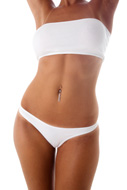- What are breast implants made of, and where are they placed?
- Should women who are pregnant or plan to be pregnant wait before undergoing a breast lift or breast reduction?
- Is there much post-operative pain from a breast lift?
- How long does recovery from plastic surgery take?
- Does breast surgery cause scarring?
- Why Does Dr. Steven Davis care so much about his patients? What makes Davis CPS different?
What are breast implants made of, and where are they placed?
 Breast implants are silicone shells filled with saline (salt water). They are placed behind each breast, underneath either breast tissue or the chest wall muscle. Placement behind the chest wall muscle offers a few advantages over placement beneath the breast tissue only. These include reduced risk of capsular contracture (post-operative tightening around the implant) and less interference with mammogram examinations. Possible disadvantages include need for drainage tubes and elevated pain in the first few days following surgery.
Breast implants are silicone shells filled with saline (salt water). They are placed behind each breast, underneath either breast tissue or the chest wall muscle. Placement behind the chest wall muscle offers a few advantages over placement beneath the breast tissue only. These include reduced risk of capsular contracture (post-operative tightening around the implant) and less interference with mammogram examinations. Possible disadvantages include need for drainage tubes and elevated pain in the first few days following surgery.
Should women who are pregnant or plan to be pregnant wait before undergoing a breast lift or breast reduction?
Women planning to have children are advised to postpone surgery, since pregnancy and nursing can counteract its effects by stretching the skin. However, the procedure should not affect your ability to breast-feed.
Breast reduction surgery is not recommended for women who intend to breast-feed, since many of the milk ducts leading to the nipples are removed.
Is there much post-operative pain from a breast lift?
Breasts will probably be bruised, swollen, and uncomfortable for a few days but this will pass. Numbness in the breasts and nipples should lessen as swelling subsides, although occasionally it lasts for months or even permanently. Stitches are removed after one to two weeks, and many patients return to work then.
How long does recovery from plastic surgery take?
 Most patients feel tired and sore after surgery, but this usually passes in a day or two and many patients return to work within a week or two. Any post-operative pain, swelling and sensitivity will diminish over the first few weeks. You should avoid heavy lifting for three to four weeks and only gentle contact with the breasts should occur for six weeks.
Most patients feel tired and sore after surgery, but this usually passes in a day or two and many patients return to work within a week or two. Any post-operative pain, swelling and sensitivity will diminish over the first few weeks. You should avoid heavy lifting for three to four weeks and only gentle contact with the breasts should occur for six weeks.
Does breast surgery cause scarring?
Yes, although scars can be hidden with a bra, bathing suit or low-cut top. During surgery, incisions are made in inconspicuous places on the breast to minimize scar visibility (in the armpit, in the crease on the underside of the breast, or around the areola, the dark skin around the nipple). Scars do fade with time.
Liposuction FAQ’s
On what areas of the body can liposuction be performed?
Liposuction sculpting can remove undesirable fat from the abdomen, waist, hips, buttocks, thighs, knees, chin, cheeks, neck and upper arms.
Are there different techniques?
There are several different methods surgeons use when performing liposuction, including tumescent liposuction, the super-wet technique, and ultrasound-assisted liposuction (UAL). In all types a tiny incision is made in as inconspicuous a place as possible. A cannula (small tube) is inserted and moved back-and-forth beneath the skin, breaking up the fat layer and suctioning it out. Tumescent liposuction and super-wet liposuction use fluid injection, which facilitates fat removal, reduces blood loss, provides anesthesia during and after surgery, and helps to reduce the amount of bruising after surgery. UAL liquefies fat with ultrasonic energy and is highly precise.
What is the recovery from liposuction like?
After surgery, drainage tubes, compression garments and antibiotics may be needed to facilitate the healing process. Patients are encouraged to walk as soon as they are able and many return to work within a few days, although strenuous activity should be avoided for about a month. Results are visible immediately, though improvement may continue as swelling subsides during the first three months. Scars are small and inconspicuous. Other irregularities in appearance are possible, such as asymmetric or “baggy” skin, numbness and pigmentation changes.
Abdominoplasty FAQ’s
Who is a good candidate for a tummy tuck (abdominoplasty)?
The best candidates are in good physical condition with pockets of fat or loose skin that haven’t responded well to diet and exercise. Older, slightly obese people whose skin has lost some of its elasticity can be helped. Abdominoplasty can also be useful for women with stretched skin and muscles from pregnancy, although results from the procedure will diminish if they continue to bear children. For this reason, women who plan to have children again are advised to delay abdominoplasty. Patients who intend to lose a lot of weight are also encouraged to wait before undergoing the procedure, since skin in that area typically loosens after substantial weight loss.
What is recovery like? Will there be scars?
Recovery time ranges from two weeks to a few months, but with a balanced diet and regular exercise results are long-lasting. Abdominoplasty will likely leave a permanent scar stretching between the hips, although it should be low enough for even a bikini to conceal it. Patients who have had previous abdominal surgery should know that their old scars could be raised, stretched or generally more noticeable after the procedure.
What is a mini-tummy tuck (partial abdominoplasty)?
Partial abdominoplasty is similar to abdominoplasty except a shorter incision is made and the skin is only lifted to the navel, which does not have to be moved (although it may be pulled into a different shape as skin is stretched).